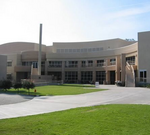Mt. San Antonio College
1946 establishments in CaliforniaCalifornia Community CollegesCross country running courses in CaliforniaMt. San Antonio CollegeSan Gabriel Valley ... and 6 more
Schools accredited by the Western Association of Schools and CollegesTwo-year colleges in the United StatesUniversities and colleges established in 1946Universities and colleges in Los Angeles County, CaliforniaUse mdy dates from January 2019Walnut, California

Mt. San Antonio College (Mt. SAC) is a public community college in Walnut, California. It offers more than 400 degree and certificate programs, 36 support programs, and more than 50 student clubs and athletic programs, including food pantry, counseling and tutoring. The college offers associate degrees, career education, community recreation courses, ESL, adult education, and youth summer programs.
Excerpt from the Wikipedia article Mt. San Antonio College (License: CC BY-SA 3.0, Authors, Images).Mt. San Antonio College
North Grand Avenue,
Geographical coordinates (GPS) Address External links Nearby Places Show on map
Geographical coordinates (GPS)
| Latitude | Longitude |
|---|---|
| N 34.047 ° | E -117.845 ° |
Address
Mt. San Antonio College
North Grand Avenue 1100
91789
California, United States
Open on Google Maps




